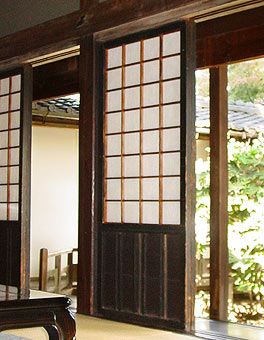|
||
 |
||

Old
Andou 安藤 house (Yamanashi)
(C)2001 Japanese Architecture and Art Net Users System. No reproduction or republication without written permission.
掲載のテキスト・写真・イラストなど、全てのコンテンツの無断複製・転載を禁じます。
|
||||||
| koshidaka shouji 腰高障子 | ||||||
| KEY WORD : architecture / general terms | ||||||
| Also called koshidaka akarishouji 腰高明障子, or only koshidaka. A translucent paper-covered sliding screen *shouji 障子, with a wainscot about 60cm high or approximately one third of its overall height. The wainscot may be made of thin wood panels with a decorative or straight grain. The vertical and horizontal rails may be arranged in groups called *fukiyose 吹寄 or with fairly closely placed horizontal rails called maira 舞良. Old style rails (15-16c) were thick and sometimes chamfered. This type is called kumite goushi 組手格子. See *mairado 舞良戸. Sometimes paper is pasted on the inner side and wickerwork attached to the outer side. When this type of shouji is used at an entrance, an oiled paper is used. Oiled paper can withstand indirect weathering and allows light to pass through it. It is sometimes used in a central corridor. After the late 16c these wainscots were often elaborately decorated. | ||||||
 Old
Andou 安藤 house (Yamanashi)
|
||||||
| REFERENCES: | ||||||
| EXTERNAL LINKS: | ||||||
| NOTES: | ||||||
(C)2001 Japanese Architecture and Art Net Users System. No reproduction or republication without written permission. 掲載のテキスト・写真・イラストなど、全てのコンテンツの無断複製・転載を禁じます。 |
||||||